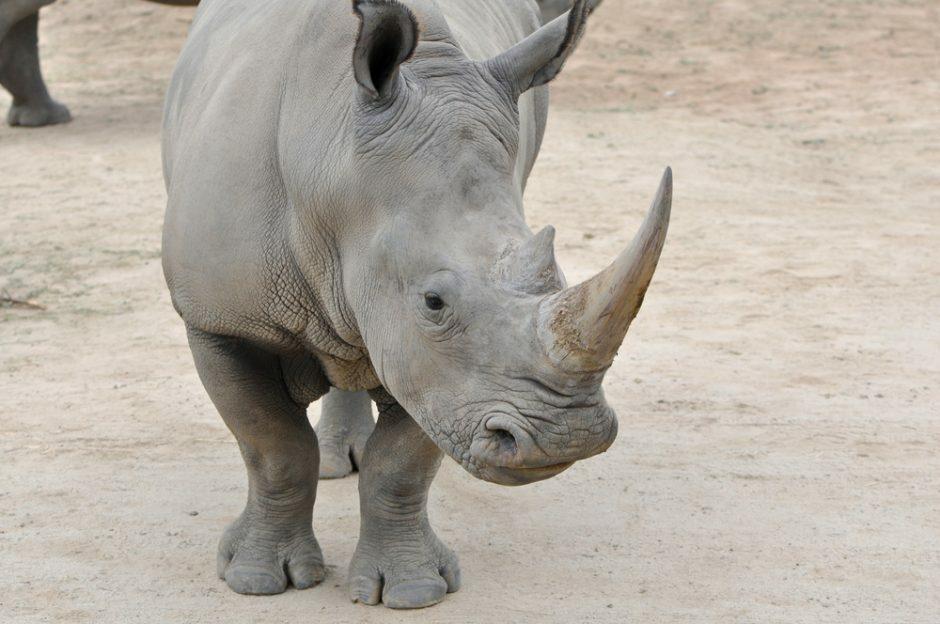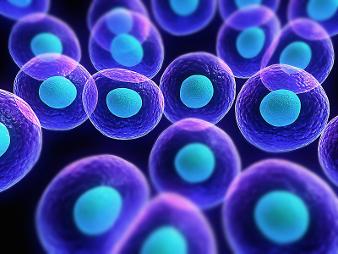
7 minute read
Br i n g Back an Ex ti n ct Rh i n o Su bsp eci es
CarolineChu
On August 6th, 2022, a new southern white rhino calf was born at the San Diego Zoo Safari Park?s Nikita Rhino Rescue Center. W hile this new m ale calf is of a different subspecies, he m arks the next step in bringing back the northern white rhino from near extinction. The last rem aining m ale northern white rhino died in M arch 2018, and the two rem aining fem ale northern white rhinos live in Kenya, but they are past reproductive age The m other of the new southern white rhino calf at the San Diego Zoo is Livia. She is a first tim e m om , and the successful birth of her calf proves that Livia is able to carry a calf to term and care for the calf This m akes Livia a vitally im portant rhino because she is one of three southern white rhinos at the zoo who could potentially be a surrogate m other for a northern white rhino em bryo.
Advertisement
Not only could Livia be the surrogate, she was also closely studied so that researchers could gain m ore knowledge about the southern white rhino?s reproductive cycle. They collected data on when the reproductive cycle begins as well as the phases. This inform ation will be applied in the future and will allow researchers to be prepared as they plan to im plant a northern white rhino em bryo into a southern white surrogate m other in the hope that the surrogate could give birth to a genetically pure northern white which will provide the foundation for repopulation
The stem cell biologists plan to use northern white rhino tissue from the San Diego Zoo W ildlife Alliance?s ?frozen zoo,?the largest cryobank in the world of anim al cells, to create a northern white em bryo. The cryobank contains skin cells from twelve different northern white rhinos which they believe is enough to create a healthy and genetically diverse rhino population. However, the challenge is that researchers are having to design the em bryo creation process from scratch They even have to design basic steps such as the correct petri dish culture, the nutritional layer of the petri dish that will allow a fertilized egg to grow. San Diego Zoo W ildlife Alliance researcher Carly Young said that the biologists used protocols developed from the horse, dom estic cat, deer, and even hum ans to create the m aturation m edia for the northern white rhino.
Before anything else, however, scientists have to be certain that their procedure will work correctly in southern white rhinos before they begin using any of their lim ited supply of northern white cells. W hile Germ an scientists have already created northern white em bryos using eggs from the two rem aining northern white rhinos, they were unable to successfully transfer em bryos. However, the San Diego Zoo is m aking progress. Two of their rhinos have already gotten pregnant from artificial insem ination which was a first for zoos in North Am erica. The insem inations using frozen sperm allowed researchers to learn even m ore about the rhino?s reproductive cycle because the rhinos were trained to have ultrasounds and other health checks, giving researchers the chance to take crucially im portant m easurem ents of the fetus
The northern white rhino skin cell sam ples are stored in nitrogen cooled freezers where stem cell biologists attem pt to get northern white rhino stem cells from these skin sam ples Stem cells are the m ost basic form of cells and are what all other cells develop from . However, researchers only have skin cells not stem cells, and this created a m ajor issue. Skin cells, like all other types of adult cells, cannot turn into other kinds of cells once developed. However, the inform ation to develop into different types of cells is still in the genetics of the skin cells, so theoretically the researchers could use that to create stem cells
To access those genes, researchers m ust first perform steps to reset and rem ove all of the cell?s program m ing to return it to a stem cell This process has been perform ed on the cells of other anim als and also hum ans, but never before on rhinos. There are four regulatory m olecules that are known as Yam anaka factors which are needed to reset a skin cell These factors control the way that DNA is copied for translation into other proteins. In 2021, the San Diego Zoo?s researchers were able to create one northern white stem cell from 100,000 skin cells Since then they have m ade adjustm ents to increase efficiency that allow them to create seven stem cells from 100,000 skin cells, and while this process still has to be optim ized, the fact that they have been able to m ake even one northern white stem cell is im pressive Since adult stem cells can becom e any cell in the rhino?s body, stem cells allow for the creation of em bryos. W hile researchers have been able to accom plish the creation of em bryos from stem cells in m ice, it has never been done before in rhinos The researchers collected skin cells from the last m ale northern white that was kept at the San Diego Zoo, and using these cells, the biologists were able to develop them into rhino heart cells. The cells, called cardiom yocytes, even expand and contract on the Petri dish naturally. These heart cells are a m ajor source of hope for the im plantation of northern white em bryos into the southern white surrogates

The second step to creating an em bryo is developing the stem cells into prim ordial, the earliest stage of cell developm ent, sperm and eggs The process of turning stem cells into sperm and egg cells is incredibly difficult. It requires sending intracellular signals at the perfect concentration, tim ing, and duration to m ake the stem cells turn into the desired type of cell The intracellular signals could be growth factors or certain chem icals that turn on or off pathways during the cell cycle. The researchers can then use the signals to direct the cell to turn into specific genes Once created, however, keeping stem cells healthy and alive is difficult. If the cells aren? t fed frequently, the growth factor m akes the stem cells m aintain their stem cell state, and then they will break down. The stem cells are also highly sensitive to heat which requires constant m onitoring of the tem perature which m ust rem ain at -321degrees Fahrenheit or else the cells will die. The stem cell biologists have developed the tedious care instructions necessary and have already yielded spectacular results.
Step three is fertilizing the egg with the sperm , both created from stem cells, to create an em bryo. The first requirem ent for fertilizing an egg is to have an alive and m ature egg and sperm However, scientists m ust now create the perfect environm ent for the egg to grow because the egg wouldn? t be inside of the ovaries The scientists have to learn to recreate the ovarian environm ent?s ?Goldilocks Zone?which is a perfect tem perature, horm one and nutrient concentrations, and ratio of gasses such as carbon dioxide and oxygen that allows the eggs to grow. To find this rare Goldilocks Zone, the scientists first experim ented with southern white rhino eggs The team at the zoo had previously only had access to eggs harvested after a southern white had passed away, and these eggs were not as healthy as those from living rhinos. In M arch 2020, the team m ade great progress and was able to successfully harvest 22 live eggs They achieved a 50%m aturation rate and produced an em bryo in an im pressive first attem pt.
The fourth step, the im plantation of the northern white em bryo, is where southern white rhinos like Livia com e into play. The fetus will grow and develop in the wom b of the southern white. This step, although it m ay sound sim ple, also presents m ajor challenges. The wom b has a dynam ic nature, and in order to support a growing fetus, the em bryo and the wom b have to be in sync with one another.
The researchers used ultrasounds to learn how to synchronize the wom b and the fetus The rhinos were trained to willingly participate in the ultrasounds The zookeepers have perform ed over 1,000 ultrasounds and have gained significant am ounts of data about the reproductive system .
The data was used to learn when in their cycle rhinos are m ost likely to accept an em bryo transfer Researchers have also developed a series of horm one treatm ents which increase a rhino?s likelihood of accepting an em bryo by inducing ovulation within 48 hours. As a sign of the researcher?s new discoveries, in 2019 two southern whites were artificially insem inated and gave birth to healthy calves. Livia has now joined them as possible surrogates for the northern white rhino em bryo.
The technology being developed for the northern white rhinos could even be applied for other endangered anim al species Oliver Ryder, the San Diego Zoo?s director of conservation genetics, places an im portance on the creation of ?a global network of frozen zoos?such as the one in San Diego because having skin cells of every species is like an insurance policy Should anything happen to the population of a species, there is the potential to bring the species back from frozen skin sam ples. This new em bryo im plantation research holds the secret to reviving a lost species as well as preventing others from going extinct
Bibliography
Dance, Am ber "San Diego's Frozen Zoo Offers Hope for Endangered Species around the World." Knowable M agazine. Sm ithsonian M agazine, www.sm ithsonianm ag.com /science-nature/san-diegos-frozen-zoo-180971276/. Accessed 27 Oct 2022
Rogers, Peter "Northern W hite Rhino: Resurrecting an Extinct Species in Four Steps." Big Think, 22 M ar. 2022, bigthink.com /life/resurrection-deextinction-northern-white-rhino/. Accessed 28 Oct 2022
Schm iedeberg, Renee "A New Hope: Southern W hite Rhino Calf Born at San Diego Zoo Safari Park " NBC 7 San Diego, NBC Universal M edia, 23 Aug 2022, www.nbcsandiego.com /news/local/a-new-hope-southern-white-rhino-calfborn-at-san-diego-zoo-safari-park/3029120/. Accessed 25 Oct. 2022.










